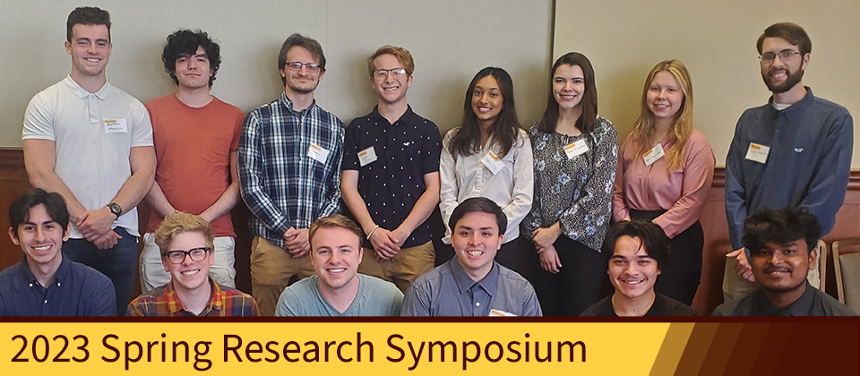2023 Spring Research Symposium
2023 Spring Research Symposium
2023 Spring Research Symposium
Here at the department, students are always working on new research projects. Students work with faculty on a wide variety of research topics, developing their programming skills beyond their classroom instruction. Each spring and summer, students get a chance to present what they’ve learned, showcasing their data to the rest of the university. Our Spring 2023 Research Symposium was a massive success, with students from every corner of the department taking center stage.
Ronald Yang Sr., Felix Hakimi Jr., Nicholas Kaegi, Soorya Baliga, and Mary Liscki researched a deep learning pipeline for the detection of aortic aneurysms, with Dr. Hieu Ngyuen and associate professor Li Yupeng as advisors. Part of this process involved using AI. There were two deep learning models, yolov5 and 3D U-net. Yolov5 detects aneurysms, and 3D U-net creates high quality models via segmentation for users to look at. The research process was also a huge learning curve, the entire project taking three years for completion. The next step in the process would be improving the AI performance, and improving the hardware.
“We’re starting to hit a computation wall,” says Baliga. “We’re currently running our own server, but the computing processes are way too big.” The students would also love to make a website for the service, where patients and doctors can upload data for further study.
Lucas Gebe developed an ultrasound simulation program for use in training, along with advisor Dr. Bo Sun. Gebe learned that while ultrasound usage was cheap, using them for training was not. Even simulations were still very expensive, so Gebe worked to replace the current market methods, using camera calibration and computer vision instead– options that don’t require complicated machinery.
“I was trying to do this all by myself, without reading any research papers, and that was a real challenge,” says Gebe. “But, finally reading research papers started pushing me to certain techs that I would later be key, such as calibration. My research would not be possible without them.” As for further research, Gebe plans to bring his developments into a real hospital where students and doctors can test the accuracy.
Justin Pitera, Dylan Lorrilliere, Christopher Shields, and Sadia Oŕpi worked with Lockheed Martin for their research, optimizing the organization’s container files. They were advised by Dr. Neil Toporski. They worked to put all the necessary files for running an application into one container file, so it could run in a set environment. This cut down on repeated files, saving massively on space and computation resources. They also created a way for users to search how many duplicate files existed, then giving the user an order in which they needed to copy said files into the container file. For them, the hardest part of the project was working with databases. Many of the students on the project had never worked with databases before, so it was a big learning curve for back end databases and different coding languages.
“In retrospect, we could’ve used more object oriented design, and not used a .net domain, as that slowed us down,” says Pitera. Their next step? Further optimizing the container files via object oriented design, adding capabilities to ignore certain files.
Nick Bovee and Jack Campanella experimented with improving response time for autonomous driving, with advisor Dr. Zhihong Wang.
“By improving response time, we can avoid property damage crashes,” says Campanella.
Bovee and Campanella achieved that by leveraging computation power the edge device, phone or device or car, in the network. When processed enough, the network can take internal weights, taking it through a server where it can leverage more power. “It was really nice to see some of the actual tests when they started to fire,” says Bovee. “We had obstacles with the Rowan network, and different edge devices. It’s a lot of very small moving parts on the neural networks side, and getting each one of those hooked together, having network servers work properly, getting splicing to different aspects– it’s very delicate. Seeing every piece working separately, and finally coming together was awesome.”
On a similar note, Ben Senatore, Billie Giasante, Bryan Rue, Bryce Pruitt, Daanyal Kaleem, and Kayla Weldon worked with advisor Dr. Neil Toproski on creating visual analytics for rideshare services in NYC. The Taxi Limousine Commission provided the data for the project. Google Maps API then visualized the data, before being passed through Polygon API. Users can then access the data via a web app, and passengers, drivers, and executives can make use of the data for decision making.
“We can see which places have high volumes of traffic, what wait times are like, what passengers pay, how much a driver makes per mile, and even how often people tip in a pickup zone,” says Senatore.
“There was a point in the dev process where we were barking up the wrong tree– it wasn't going well. The API had documentation issues, and once we figured out how to pass through polygons, the zones started working. Total plug and play,” says Rue, on struggles they faced during the research process. As for what’s next, the group plans on getting even more granular with their visualizations, in an attempt to create more correlations between different views.
The Spring Research Symposium was an outstanding success, and should serve as a goalpoint for all students working, or wanting to work on research for next semester’s symposium. Get your feet wet with research this fall!
Written by Kiley Parker | Posted 2023.9.22
